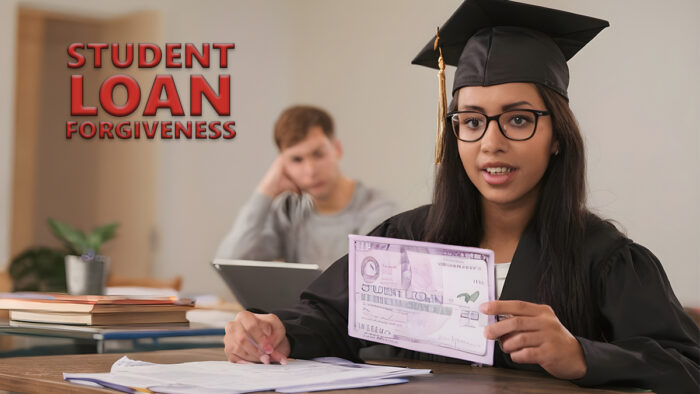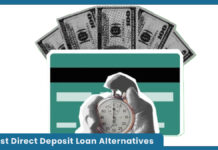Most people who graduated from college still have their student loans to pay off. This can cause students to feel overwhelmed and question if they will ever be able to repay their student loan debt. However, one of the solutions to clearing your student loan debt is with student loan forgiveness.

Student loan forgiveness discharges or cancels part or all of your federal student loan debt. There are different types of loan forgiveness programs that you can apply for. However, you need to meet their eligibility requirements.
What Is Student Loan Forgiveness?
Student loan forgiveness is a program or policy that allows borrowers to have some or all of their student loan debt canceled. This means they are no longer obligated to repay the forgiven portion of their loans.
This forgiveness can be granted for various reasons, such as working in certain public service professions, making a certain number of on-time payments through income-driven repayment plans, or meeting other specific criteria set by the loan forgiveness program.
The goal is to provide relief to borrowers who may struggle to repay their student loans due to financial hardship or other circumstances.
How Does Student Loan Forgiveness Work?
In financial parlance, loan forgiveness entails forgiving or eliminating a portion or all of your loan. This relieves the borrower of the duty to repay the loan. The United States Department of Education provides different forgiveness and discharge programs.
Although any student loan can be forgiven, student loan forgiveness applies to government-backed loans or U.S. government-issued loans. Student loan forgiveness programs don’t apply to privately issued loans, such as those from lenders or commercial banks, even if the loans are designed for students.
For borrowers with qualified loans, loan forgiveness might be an option. People who want their loans forgiven must apply and might have to continue making payments for the loan until the forgiveness application is approved.
Loans Eligible for Forgiveness
Although several borrowers would like to have their student loans forgiven, only a few have the opportunity to do so. Each type of loan has its own requirements. However, most provide forgiveness only for people employed in specific public service occupations.
These include nonprofit employees, teachers, members of the military, and government employees. Furthermore, not all federal loans are eligible. Student loans qualified for forgiveness are direct loans, Perkins loans, and for special groups such as teachers, Federal Family Education Loans.
There is also a repayment plan offered to student loan borrowers, which includes forgiveness or discharge of some of their debt.
Benefits of Student Loan Forgiveness
There are several perks that student loan forgiveness offers, and they include:
- Most programs don’t come with a federal tax bill: The IRS considers forgiven or cancelled debt to be taxable income. This can lead to a sizable tax bill. In most federal student loan forgiveness programs, the forgiven loan balance is not subject to federal income taxes. However, some states might require you to pay taxes.
- You can get up to 100% of your debt forgiven: Some federal student loan forgiveness programs offer complete forgiveness of your loan balance as soon as you have met the program requirements.
- You can minimize monthly payments: If you are eligible for student loan forgiveness, then getting on an income-driven repayment plan makes your payments cheaper until you can meet other requirements for cancellation.
These are the benefits of getting your student loan discharged or forgiven.
Types of Student Loan Forgiveness
There are several ways that you can get part or all of your student loan debt forgiven, and they include:
Public Service Loan Forgiveness
The Public Service Loan Forgiveness Program is designed for people who work in public service jobs for a non-profit organization or the government. You might also be able to get part of your loan or your entire loan forgiven due to volunteer work, medical practice, or military service.
You might be eligible for this loan forgiveness if you have a Federal Family Education Loan or a Perkins Loan that has been rolled into a Direct Consolidation Loan. With this program, borrowers working for qualified employers can have the rest of their federal student loans forgiven after making 120 eligible monthly payments.
Note that the public service loan forgiveness is employer-based and not role-based. So you don’t need to be a firefighter, police officer, or teacher to qualify. You can determine if you work for a qualified employer by using Federal Student Aid’s employer eligibility tool.
How to Qualify
To be eligible for public service loan forgiveness, you must:
- Work full-time for a United States federal, state, local, or tribal government or an eligible non-profit.
- You must enroll in an income-driven repayment plan that calculates payments as a percentage of your discretionary income and also extends the repayment terms.
- You must have federal direct loans.
Keep in mind that public service loan forgiveness is not automatic. This means that you must apply and regularly certify your employment to be able to stay on track.
Income-Driven Repayment Plans
Income-driven repayment plans are available for all federal student loan borrowers. However, the plans you are eligible for can vary based on the type of loan and your financial situation.
If you are unable to afford your monthly payments under a 10-year standard repayment plan, then you can reduce your payments and be eligible for loan forgiveness by applying for the Income-Driven Repayment Plan. Under this plan, your loan servicers lengthen your loan repayment program to 20 or 25 years. There are four types of IDR plans, and they include:
- Income-Based Repayment (IBR): You will pay for 10% of your discretionary income and then have a loan term of over 20 to 25 years.
- Pay As You Earn (PAYE): The maximum monthly payments will be 10% of discretionary income. To be eligible for loan forgiveness, you need to have over 20 years of qualifying payments. The government might even pay part of the interest on the loan.
- Income-Contingent Repayment (ICR): The payments are recalculated every year depending on gross income, outstanding loan balance, and family size.
- Revised Pay As You Earn (REPAYE): If you applied for a loan to pay for graduate school, then your repayment term is over 25 years. If the loans were for an undergraduate degree, then your repayment term is up to 20 years. Your monthly payment is 10% of your discretionary income.
Teacher Loan Forgiveness Program
The Teacher Loan Forgiveness Program provides up to $17,500 in student loan forgiveness to teachers who have Direct or FFEL program loans after teaching full-time for five consecutive years.
This type of loan forgiveness is specially designed for a highly qualified teacher who works in an educational service agency or low-income school.
How to Qualify
- You must have a bachelor’s degree and full state certification as a teacher.
- You must have federal direct or Federal Family Education Loan Program loans.
- You must work full-time for an elementary school, education service, or secondary school.
You will need to apply for the Teachers Loan Forgiveness Program. Note that if you are eligible for both programs, you can’t get credit for both simultaneously.
Health Professional Loan Repayment
If you work in an eligible healthcare role, you can qualify for student loan assistance through organizations such as the National Institutes of Health (NIH) or the National Health Services Corps.
The NHSC provides up to $120,000 in loan assistance for eligible full-time healthcare professionals, while the NIH offers up to $50,000 each year to healthcare professionals who are conducting qualified research.
The qualified nurses might also be eligible for up to 60% loan payoff via the Nurse Corps loan repayment program in return for a two-year service commitment. To be qualified for this loan forgiveness, you need to have licensed healthcare professionals working in eligible roles.
Who Is Eligible for Student Loan Forgiveness?
To be eligible for student loan forgiveness, you need to meet the requirements, which include:
- You qualify for Perkins loan cancellation.
- If you make payments for 20 to 25 years on an IDR plan.
- You work full-time in public service for 10 years and make 120 qualifying payments on your federal student loans.
- If you have experienced a total and permanent disability.
- You are a nurse serving a high-need population in a critical shortage area.
- You are a teacher at a low-income school.
If you can meet the requirements above, then you can be eligible for student loan forgiveness.
Student Loan Forgiveness vs. Student Loan Discharge
Student loan forgiveness is not the same as student loan discharge. Loan forgiveness happens when a specific government exempts you from making payments on your loan. Loan discharge occurs when the borrower becomes permanently disabled, dies, or declares bankruptcy.
How Do I Get Student Loans Forgiven?
There are two ways to get your student loans forgiven. The first is to consolidate all your loans into a single debt. Then you can apply for forgiveness by filing a special application, which is the Federal Student Aid’s Public Service Loan Forgiveness (PSLF) and Temporary Expanded PSLF (TEPSLF) Certification and Application.



